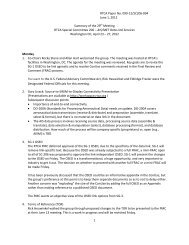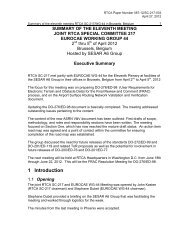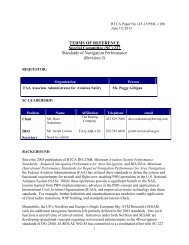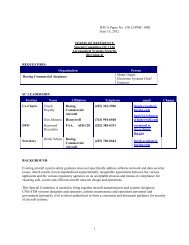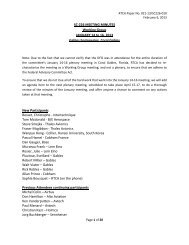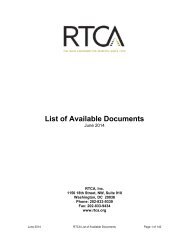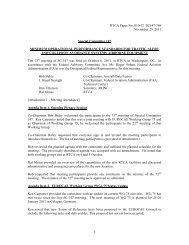Summary of the First Meeting Special Committee 227 ... - RTCA
Summary of the First Meeting Special Committee 227 ... - RTCA
Summary of the First Meeting Special Committee 227 ... - RTCA
You also want an ePaper? Increase the reach of your titles
YUMPU automatically turns print PDFs into web optimized ePapers that Google loves.
2000’s and earlier and <strong>the</strong> expanding needs globally in <strong>the</strong> future. He pointed out that one <strong>of</strong> <strong>the</strong> steps<br />
taken was through ICAO. Specifically <strong>the</strong> formation <strong>of</strong> <strong>the</strong> ICAO RNP <strong>Special</strong> Operational<br />
Requirements Study Group (RNPSORSG) around 2004 and its successor <strong>the</strong> Performance Based<br />
Navigation Study Group (PBN SG) from 2008 until <strong>the</strong> present was an effort to increase <strong>the</strong><br />
understandability <strong>of</strong> RNAV and RNP, though greater harmonization and consistency in <strong>the</strong> types <strong>of</strong><br />
RNAV and RNP criteria for aircraft qualification, operational approval and implementation<br />
considerations. This effort represented <strong>the</strong> creation <strong>of</strong> and transition to PBN and <strong>the</strong> development <strong>of</strong> <strong>the</strong><br />
PBN Manual, ICAO Doc 9613. Mark pointed out that one <strong>of</strong> <strong>the</strong> key aspects <strong>of</strong> PBN was <strong>the</strong><br />
differentiation between RNAV and RNP. While both have performance requirements, RNP has on-board<br />
performance monitoring and alerting (OBPMA). It is OBPMA where <strong>the</strong> greater assurance <strong>of</strong> RNP<br />
system performance is provided. Mark also highlighted with examples that <strong>the</strong>re is still room and a need<br />
for more improvement to reduce <strong>the</strong> operational variability in aircraft flight path performance.<br />
Bruce DeCleene is <strong>the</strong> manager <strong>of</strong> <strong>the</strong> Aircraft Certification group, AIR-130. Bruce started out by setting<br />
a number <strong>of</strong> considerations as SC<strong>227</strong> goes forward. Specifically, he pointed out folding in lessons<br />
learned such as<br />
pilot awareness <strong>of</strong> sensor inputs,<br />
speed/altitude,<br />
wrong runway entry<br />
global harmonization through linkage to <strong>the</strong> ICAO navigation specifications, and raising <strong>the</strong> bar on<br />
performance and capability where it’s appropriate such as<br />
pilot and air traffic expectations,<br />
turn performance, including fixed radius and<br />
support <strong>of</strong> TSE monitoring and alerting.<br />
JohnH: Is <strong>the</strong>re regulatory basis on <strong>the</strong> PBN manual document Were <strong>the</strong> same experts as here involved<br />
in writing <strong>the</strong> PBN manual<br />
MarkS (PBN Study Group, US Member): The PBN manual was meant to embrace existing equipment.<br />
It was not meant as a certification document.<br />
DaveN (Chair <strong>of</strong> PBN Study Group and ICCAIA Member): The PBN manual has not been used<br />
consistently in <strong>the</strong> way we expected. It is being used as a regulatory document by some states without <strong>the</strong><br />
appropriate considerations that must be made and as spelled out in <strong>the</strong> manual itself.<br />
Ge<strong>of</strong>fB (PBN Study Group, UK Member): There was a proliferation <strong>of</strong> standards that needed to be<br />
focused. That harmonization is focused at <strong>the</strong> regulatory level. The problem is that <strong>the</strong> linkage with<br />
MASPS and MOPS has been lost. The MASPS and MOPS didn’t have any force into usage in service.<br />
As a result we have had a proliferation <strong>of</strong> standards and applications. The challenge is to bring it all back<br />
toge<strong>the</strong>r. The only way to have airspace development is to have interoperability and aircraft meeting a<br />
standard.<br />
BruceDC(RNP SORSG, FAA Member): SC181 did a good job laying a foundation. What has happened<br />
since is taking that and turning it into practice. It has not been simple with RNP, RNAV, and RNP<br />
RNAV. The need is to reestablish <strong>the</strong> connection between <strong>the</strong> operational side developed since SC181<br />
back into <strong>the</strong> equipment standards.<br />
JH: Is <strong>the</strong>re a comment period for <strong>the</strong> new PBN manual<br />
Erwin (PBN Study Group, ICAO Secretariat, and PBN Program Manager): There is sort <strong>of</strong> a comment<br />
process but it must be through attendee members.<br />
MarkS: There is also no intent to create specs that distinguish between GA and AT. Please provide<br />
feedback through me. We try to minimize differences between expectations <strong>of</strong> how FAA and EASA will<br />
use <strong>of</strong> <strong>the</strong> manual.<br />
4




